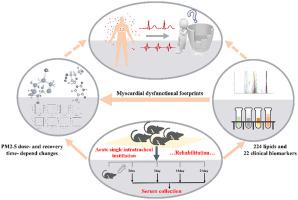Journal of Hazardous Materials ( IF 12.2 ) Pub Date : 2021-02-24 , DOI: 10.1016/j.jhazmat.2021.125504 Xi Zhang , Jie Zhang , Yan Wu , Bingru Nan , Qingyu Huang , Xiaoyan Du , Meiping Tian , Liangpo Liu , Yuntian Xin , Yanbo Li , Junchao Duan , Rui Chen , Zhiwei Sun , Heqing Shen

|
Many studies have linked airborne fine particulate matter (PM2.5) exposure to cardiovascular diseases. We performed a time-series analysis to investigate whether the disruption of lipid metabolism recovered or lasted after acute PM2.5 exposure in mice. Targeted lipidomic analysis showed that four major plasma membrane phospholipids along with cholesterol esters (CE) were significantly altered on 7th post-exposure day (PED7), and the alteration reached a peak on PED14. On PED21, the phosphatidylcholine (PC) decrease was more marked than on PED14, and its resurgence was indirectly linked to triglyceride (TG) increase. Homocysteine (HCY), lactate dehydrogenase (LDH), and α-hydroxybutyrate dehydrogenase (α-HBDH) levels increased but glucose levels decreased markedly in a dose- and time-dependent manner throughout the experimental period. Network analysis showed that the lasting lipid deregulation on PED21 correlated to myocardial markers and glucose interruption, during which high-density lipoprotein cholesterol (HDL-C) decreased. The present data implied that the constructional membrane lipids were initially interrupted by PM2.5, and the subsequent rehabilitation resulted in the deregulation of storage lipids; the parallel myocardial and glucose effects may be enhanced by the lasting HDL-C lipid deregulation on PED21. These myocardial and lipidomic events were early indicators of cardiovascular risk, resulting from subsequent exposure to and accumulation of PM2.5.
中文翻译:

雄性小鼠急性单个细颗粒物暴露后的动态恢复:对脂质调节和心血管改变的影响
许多研究将空气中的细颗粒物(PM2.5)暴露与心血管疾病联系起来。我们进行了时间序列分析,以研究小鼠急性PM2.5暴露后脂质代谢的破坏是恢复还是持续。靶向脂质组学分析显示,在暴露后第7天(PED7),四种主要的质膜磷脂以及胆固醇酯(CE)发生了显着变化,并且该变化在PED14上达到了峰值。在PED21上,磷脂酰胆碱(PC)的下降比在PED14上更为明显,并且其回潮与甘油三酸酯(TG)的上升间接相关。在整个实验期间,同型半胱氨酸(HCY),乳酸脱氢酶(LDH)和α-羟基丁酸脱氢酶(α-HBDH)含量增加,但葡萄糖含量以剂量和时间依赖性方式显着下降。网络分析表明,PED21上持久的脂质失调与心肌标志物和葡萄糖中断有关,在此期间高密度脂蛋白胆固醇(HDL-C)下降。目前的数据表明,建筑膜脂最初被PM2.5阻断,随后的修复导致储脂的失控;在PED21上持久的HDL-C脂质去调节作用可能会增强并行的心肌和葡萄糖作用。这些心肌和脂质组学事件是心血管风险的早期指标,其源于随后暴露于PM2.5和积累PM2.5。目前的数据表明,建筑膜脂最初被PM2.5阻断,随后的修复导致储脂的失控;在PED21上持久的HDL-C脂质去调节作用可能会增强并行的心肌和葡萄糖作用。这些心肌和脂质组学事件是心血管风险的早期指标,其源于随后暴露于PM2.5和积累PM2.5。目前的数据表明,建筑膜脂最初被PM2.5阻断,随后的修复导致储脂的失控;在PED21上持久的HDL-C脂质去调节作用可能会增强并行的心肌和葡萄糖作用。这些心肌和脂质组学事件是心血管风险的早期指标,其源于随后暴露于PM2.5和积累PM2.5。











































 京公网安备 11010802027423号
京公网安备 11010802027423号